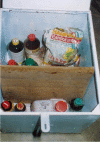Community uptake of safe storage boxes to reduce self-poisoning from pesticides in rural Sri Lanka
- PMID: 17257415
- PMCID: PMC1796869
- DOI: 10.1186/1471-2458-7-13
Community uptake of safe storage boxes to reduce self-poisoning from pesticides in rural Sri Lanka
Abstract
Background: Acute poisoning by agricultural pesticides is a well established global public health problem. Keeping pesticides under safe storage is now promoted as a potential way to reduce the number of severe poisoning cases. However, there have been no published studies documenting the feasibility of such an approach. Therefore, the objective of the study presented here was to determine community perceptions and use of in-house safe storage boxes for pesticides in rural Sri Lanka.
Methods: Boxes with a lock, to be used for the in-house safe storage of pesticides, were distributed to 200 randomly selected farming households in two agricultural communities. A baseline survey determined pesticide storage practices and household characteristics prior to distribution. The selected households were encouraged to make use of the box at community meetings and during a single visit to each household one month after distribution. No further encouragement was offered. A follow-up survey assessed storage practices seven months into the project.
Results: Following the distribution of the boxes the community identified a number of benefits including the protection of pesticide containers against exposure from the rain and sun and a reduced risk of theft. Data were analysed for 172 households that reported agricultural use of pesticides at follow-up. Of these, 141 (82%) kept pesticides in the house under lock against 3 (2%) at baseline. As expected, the distribution of boxes significantly reduced the number of households storing pesticides in the field, from 79 (46%) at baseline to 4 (2%) at follow-up. There was a significant increase in the number of households keeping pesticides safe from children between baseline (64%) and seven months after the distribution of boxes (89%). The same was true for adults although less pronounced with 51% at baseline and 66% at follow-up.
Conclusion: The farming community appreciated the storage boxes and made storage of pesticides safer, especially for children. It seems that additional, intensive promotion is needed to ensure that pesticide boxes are locked. The introduction of in-house safe storage boxes resulted in a shift of storage into the farmer's home and away from the field and this may increase the domestic risk of impulsive self-poisoning episodes. This increased risk needs attention in future safe storage promotion projects.
Figures
Similar articles
-
Safe storage of pesticides in Sri Lanka - identifying important design features influencing community acceptance and use of safe storage devices.BMC Public Health. 2008 Aug 5;8:276. doi: 10.1186/1471-2458-8-276. BMC Public Health. 2008. PMID: 18681976 Free PMC article.
-
Evaluation of acceptability and use of lockable storage devices for pesticides in Sri Lanka that might assist in prevention of self-poisoning.BMC Public Health. 2009 Feb 24;9:69. doi: 10.1186/1471-2458-9-69. BMC Public Health. 2009. PMID: 19239714 Free PMC article.
-
Effectiveness of household lockable pesticide storage to reduce pesticide self-poisoning in rural Asia: a community-based, cluster-randomised controlled trial.Lancet. 2017 Oct 21;390(10105):1863-1872. doi: 10.1016/S0140-6736(17)31961-X. Epub 2017 Aug 11. Lancet. 2017. PMID: 28807536 Free PMC article. Clinical Trial.
-
How many premature deaths from pesticide suicide have occurred since the agricultural Green Revolution?Clin Toxicol (Phila). 2020 Apr;58(4):227-232. doi: 10.1080/15563650.2019.1662433. Epub 2019 Sep 9. Clin Toxicol (Phila). 2020. PMID: 31500467 Review.
-
Identification of strategies to prevent death after pesticide self-poisoning using a Haddon matrix.Inj Prev. 2006 Oct;12(5):333-7. doi: 10.1136/ip.2006.012641. Inj Prev. 2006. PMID: 17018677 Free PMC article. Review.
Cited by
-
Letter to the Editor: Problems with studying community-level pesticide storage to prevent suicide.Trials. 2021 Jan 28;22(1):103. doi: 10.1186/s13063-021-05052-8. Trials. 2021. PMID: 33509247 Free PMC article. No abstract available.
-
Suicide Attempts and Deaths in Sofala, Mozambique, From 2011 to 2014.Crisis. 2016 Nov;37(6):445-453. doi: 10.1027/0227-5910/a000383. Epub 2016 Jun 1. Crisis. 2016. PMID: 27245814 Free PMC article.
-
Safe storage of pesticides in Sri Lanka - identifying important design features influencing community acceptance and use of safe storage devices.BMC Public Health. 2008 Aug 5;8:276. doi: 10.1186/1471-2458-8-276. BMC Public Health. 2008. PMID: 18681976 Free PMC article.
-
Relationship of the high proportion of suicidal acts involving ingestion of pesticides to the low male-to-female ratio of suicide rates in China.Epidemiol Psychiatr Sci. 2020 Apr 17;29:e114. doi: 10.1017/S2045796020000244. Epidemiol Psychiatr Sci. 2020. PMID: 32299524 Free PMC article.
-
Feasibility of hair sampling to assess levels of organophosphate metabolites in rural areas of Sri Lanka.Environ Res. 2016 May;147:207-11. doi: 10.1016/j.envres.2016.02.011. Epub 2016 Feb 16. Environ Res. 2016. PMID: 26894816 Free PMC article.
References
-
- WHO The Impact of Pesticides on Health: Preventing Intentional and Unintentional Deaths from Pesticide Poisoning http://www.who.int/mental_health/prevention/suicide/en/PesticidesHealth2... - PubMed
Publication types
MeSH terms
Substances
LinkOut - more resources
Full Text Sources
Medical
Research Materials



